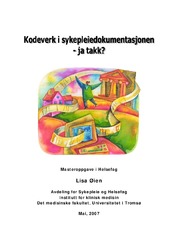| dc.description.abstract | This master thesis presents the arguments a few nursing leaders give – for using nursing
classification systems, others – for not using the same systems. Their arguments are then
debated up against the ongoing theoretical and political debate regarding the same subject –
use of nursing classifications.
The classification systems presented in this thesis are NANDA (North American Nursing
Diagnoses Association), and NIC (Nursing Interventions Classification). These classification
systems are introduced to Norwegian nurses through a system for electronic patient record
(EPR) called DIPS. DIPS offer, among other things, a module for nursing documentation that
is adapted for the use of NIC and NANDA.
Some arguments regarding these systems, concerns practical consequences. It is clamed that
the use of classifications will make documenting more sufficient, and by that, help increase
the quality on patient care. Other arguments concerns an ongoing debate on how nursing in
general, should be organized in the future. An occupational debate where some nurses see the
consequence of classification systems as beneficiary for future nursing, while yet others, feel
the consequences will be more profound and even damaging, than we as of now, seem to
realise.
Examples on expected positive effect of nursing classifications are; up-to-date procedures and
more unified nursing practise, better- and more rapidly outset treatment and less danger of
unclear reports leading to misunderstandings between the health-workers. More efficient use
of data for statistics and research are presumed to make nursing more “visible” to the public
and help even further professionalise it, making it less marginalized by producing a scientific
body of knowledge about nursing. The use of classification systems are also expected to have
positive effect on the skills of the nurses, through the improved access to nursing diagnoses
and –interventions NANDA and NIC will provide, and thereby help improve the vocational
training. On the other hand, the sceptics point out the danger of a reduced quality in patient
treatment, through lack of individual adjustment of procedures due to predefined and coded
language, in addition to a change in the very attitude towards the patient. Classification
systems are based on an increasing focus on efficiency and economy, contrary to the
4
“humanistic” approach nursing traditionally has been based on. In other words, some feel that
in long term, the use of nursing classifications will undermine the fundamental qualities
nursing are based upon.
NIC and NANDA are currently, by several contributors to the development of electronic
nursing documentation systems, described as the most developed, and the generally best
classification systems available. These two are translated into Norwegian, and are currently
used by nurses in several Norwegian hospitals. This thesis presents, as mentioned before,
some nursing leaders experience with, and reactions to, these classification systems. Even
though these leaders have made different priorities regarding use of the systems, they are
unanimous in their judgement on the translations of NIC and NANDA. It should have been
more “Norwegianised”. An adjustment to Norwegian conditions has still not been done; even
they are already in use in several hospitals across the country.
The thesis focus on, in what way we can argue that language and cultural factors play a role in
how NIC and NANDA are valued by these leaders. It will also present possible consequences
to the fact that NIC and NANDA are merely translated, and not at all adjusted to the
Norwegian nursing culture, nor Norwegian law, -consequences on practical issues, as well as
consequences on the future use of NIC and NANDA.
Keywords:
Electronic documentation, classification systems, NIC, NANDA, language, authorised
translation, DIPS, EPR, quality of nursing, nursing knowledge, professionalize. | en |


 English
English norsk
norsk